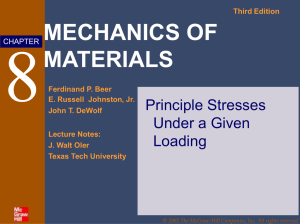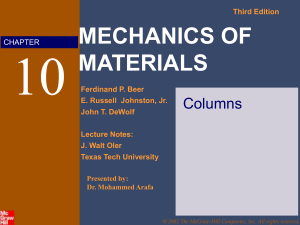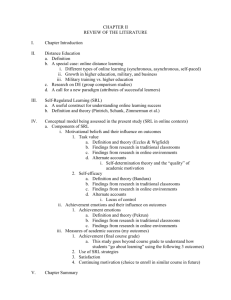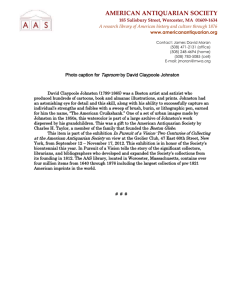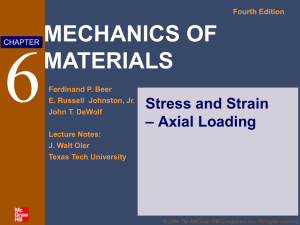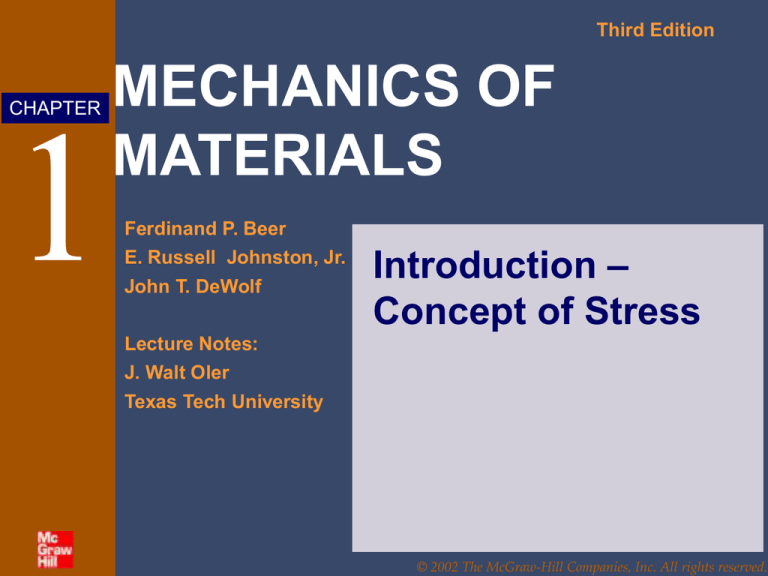
Third Edition
CHAPTER
1
MECHANICS OF
MATERIALS
Ferdinand P. Beer
E. Russell Johnston, Jr.
John T. DeWolf
Introduction –
Concept of Stress
Lecture Notes:
J. Walt Oler
Texas Tech University
© 2002 The McGraw-Hill Companies, Inc. All rights reserved.
MECCANICA DEI MATERIALI 3/ed
Beer • Johnston • DeWolf
Contents
Concept of Stress
Bearing Stress in Connections
Review of Statics
Stress Analysis & Design Example
Structure Free-Body Diagram
Rod & Boom Normal Stresses
Component Free-Body Diagram
Pin Shearing Stresses
Method of Joints
Pin Bearing Stresses
Stress Analysis
Stress in Two Force Members
Design
Stress on an Oblique Plane
Axial Loading: Normal Stress
Maximum Stresses
Centric & Eccentric Loading
Stress Under General Loadings
Shearing Stress
State of Stress
Shearing Stress Examples
Factor of Safety
© 2002 The McGraw-Hill Companies, srl
1-2
MECCANICA DEI MATERIALI 3/ed
Beer • Johnston • DeWolf
Concept of Stress
• The main objective of the study of mechanics
of materials is to provide the future engineer
with the means of analyzing and designing
various machines and load bearing structures.
• Both the analysis and design of a given
structure involve the determination of stresses
and deformations. This chapter is devoted to
the concept of stress.
© 2002 The McGraw-Hill Companies, srl
1-3
MECCANICA DEI MATERIALI 3/ed
Beer • Johnston • DeWolf
Review of Statics
• The structure is designed to
support a 30 kN load
• The structure consists of a
boom and rod joined by pins
(zero moment connections) at
the junctions and supports
• Perform a static analysis to
determine the internal force in
each structural member and the
reaction forces at the supports
© 2002 The McGraw-Hill Companies, srl
1-4
MECCANICA DEI MATERIALI 3/ed
Beer • Johnston • DeWolf
Structure Free-Body Diagram
• Structure is detached from supports and
the loads and reaction forces are indicated
• Conditions for static equilibrium:
M C 0 Ax 0.6 m 30 kN 0.8 m
Ax 40 kN
Fx 0 Ax C x
C x Ax 40 kN
Fy 0 Ay C y 30 kN 0
Ay C y 30 kN
• Ay and Cy can not be determined from
these equations
© 2002 The McGraw-Hill Companies, srl
1-5
MECCANICA DEI MATERIALI 3/ed
Beer • Johnston • DeWolf
Component Free-Body Diagram
• In addition to the complete structure, each
component must satisfy the conditions for
static equilibrium
• Consider a free-body diagram for the boom:
M B 0 Ay 0.8 m
Ay 0
substitute into the structure equilibrium
equation
C y 30 kN
• Results:
A 40 kN C x 40 kN C y 30 kN
Reaction forces are directed along boom
and rod
© 2002 The McGraw-Hill Companies, srl
1-6
MECCANICA DEI MATERIALI 3/ed
Beer • Johnston • DeWolf
Method of Joints
• The boom and rod are 2-force members, i.e.,
the members are subjected to only two forces
which are applied at member ends
• For equilibrium, the forces must be parallel to
to an axis between the force application points,
equal in magnitude, and in opposite directions
• Joints must satisfy the conditions for static
equilibrium which may be expressed in the
form of a force triangle:
F
B 0
FAB FBC 30 kN
4
5
3
FAB 40 kN
© 2002 The McGraw-Hill Companies, srl
FBC 50 kN
1-7
MECCANICA DEI MATERIALI 3/ed
Beer • Johnston • DeWolf
Stress Analysis
Can the structure safely support the 30 kN
load?
• From a statics analysis
FAB = 40 kN (compression)
FBC = 50 kN (tension)
• At any section through member BC, the
internal force is 50 kN with a force intensity
or stress of
dBC = 20 mm
P
50 103 N
BC
159 MPa
A 314 10-6 m 2
• From the material properties for steel, the
allowable stress is
all 165 MPa
• Conclusion: the strength of member BC is
adequate
© 2002 The McGraw-Hill Companies, srl
1-8
MECCANICA DEI MATERIALI 3/ed
Beer • Johnston • DeWolf
Design
• Design of new structures requires selection of
appropriate materials and component dimensions
to meet performance requirements
• For reasons based on cost, weight, availability,
etc., the choice is made to construct the rod from
aluminum all= 100 MPa). What is an
appropriate choice for the rod diameter?
P
all
A
A
d2
A
4
d
4A
P
all
50 103 N
100 106 Pa
4 500 10 6 m 2
500 10 6 m 2
2.52 102 m 25.2 mm
• An aluminum rod 26 mm or more in diameter is
adequate
© 2002 The McGraw-Hill Companies, srl
1-9
MECCANICA DEI MATERIALI 3/ed
Beer • Johnston • DeWolf
Axial Loading: Normal Stress
• The resultant of the internal forces for an axially
loaded member is normal to a section cut
perpendicular to the member axis.
• The force intensity on that section is defined as
the normal stress.
F
A0 A
lim
ave
P
A
• The normal stress at a particular point may not be
equal to the average stress but the resultant of the
stress distribution must satisfy
P ave A dF dA
A
• The detailed distribution of stress is statically
indeterminate, i.e., can not be found from statics
alone.
© 2002 The McGraw-Hill Companies, srl
1 - 10

